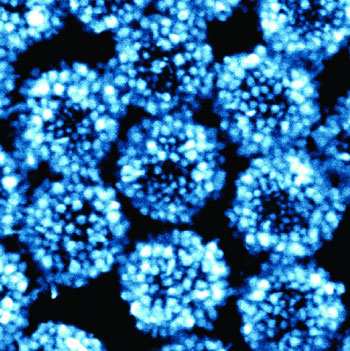| Posted: Mar 12, 2015 |
Raspberry-like nanostructures as light-bending metamaterials
|
|
(Nanowerk News) The field of metamaterials is all about making structures that have physical properties that aren’t found in nature. Predicting what kinds of structures would have those traits is one challenge; physically fabricating them is quite another, as they often require precise arrangement of constituent materials on the smallest scales.
|
|
Researchers at the University of Pennsylvania have now devised a way of mass-producing metamaterials that exhibit magnetic resonance in optical frequencies. Called “raspberry-like metamolecules” due to their unique shape, these nanoscale structures could be used as building blocks for metamaterials that could scatter light as if they had magnetic properties, which could be relevant to applications in optical processing and signal handling. These raspberry-like metamolecules react to light’s magnetic field as a loop of wire does to an oscillating magnet.
|
 |
| These raspberry-like metamolecules react to light’s magnetic field as a loop of wire does to an oscillating magnet.
|
|
This ability stems from the precise arrangements of the raspberry-like metamolecule’s “drupelets,” which are composed of gold nanoparticles. These drupelets need to be as close as possible without touching so as not to “short circuit” the optical electric fields around them. Through a carefully designed chemical process that coated each drupelet with an insulating surfactant, the Penn team was able to space these nanoparticles an average distance of just two nanometers apart.
|
|
And because the assembly of the nanoparticle drupelets and the surfactant coating can be done in a single step, vast quantities of these raspberry-like metamolecules can be fabricated at once, rather than being painstakingly assembled one at a time.
|
|
It was published in the journal ACS Nano ("Raspberry-like Metamolecules Exhibiting Strong Magnetic Resonances").
|
|
If one takes a loop of wire and passes a magnet up and down through the center, the resulting oscillating magnetic field drives electrons around the wire, producing electrical current in the wire. That principle is in play in every generator, which has magnets that oscillate at around 50 hertz, or 50 times a second. But what if this principle could be extended into optical frequencies, on the order of 500 terahertz? Rather than generating electricity, the loop would be able to manipulate visible light.
|
|
“There are no known materials that have magnetic properties in optical frequencies,” Fahkraai said. “If you could fabricate structures like this, they could be building blocks for metamaterials that could scatter light as if they had magnetic properties.”
|
|
Engheta predicted that such a structure was possible in 2006, and in the intervening years other research groups have physically produced metamaterials that exhibit this trait. Such structures were mostly painstakingly constructed rings of metal nanoparticles, spaced on a flat surface such that electrons couldn’t actually move between them.
|
|
“Because the metal doesn’t touch,” Engheta said, “the electrons can only oscillate within individual particles and can’t move from one nanoparticle to its neighbor. This is known as a displacement current. It’s like doing the wave in a stadium; no one fan is moving from their seat, but the wave moves around in a circle.”
|
|
A raspberry-like configuration, where nanoparticles are spherically clustered around a core, rather than a ring, would be even better, as a cross-section of the raspberry acts like a ring of nanoparticles no matter which direction the magnetic field is applied. Other researchers have begun moving from mechanical assembly techniques toward the chemical self-assembly of such structures but have hit roadblocks.
|
|
The Penn team’s approach solves the problems by adopting a synthetic approach.
|
|
“People have tried to make these kinds of structures in solution before, typically by assembling pre-synthesized nanoparticles,” Qian said, “but it is hard to achieve high density of nanoparticles packing through that route.”
|
|
“In our case,” Park said, “we generate closely packed nanoparticle clusters by a synthetic approach where the nanoparticle growth and assembly occurs simultaneously. A challenge in such synthetic approach is that growing nanoparticles tend to form a fused shell. In our method, we use a special surfactant that forms a molecularly-thin, but tightly protecting, layer around the nanoparticles, which keeps them from touching each other.“
|
|
The Penn team’s synthetic method reduces some of the complexity that otherwise comes with making these raspberry-like metamolecules.
|
|
“It’s like making a stew,” Engheta said. “You throw everything into one pot.”
|
|
The ingredients to the stew are polystyrene spheres decorated with small silver seed particles, silver nitrate, gold salts and reducing agents that break up those salts and allow the gold atoms to form nanoparticles. All of these ingredients are placed into a growth formula containing the insulating surfactant, which forms a thin layer on the exterior of the growing gold nanoparticles, cushioning them from each other.
|
|
Further research on the surfactant chemistry will enable the team to reduce the distance between the nanoparticles even more, to further strengthen the magnetic properties of the raspberry-like metamolecules. That trait is critical to the structures’ abilities to manipulate light and thus be used in optical devices.
|
|
“If you want to make inductors at optical frequencies,” Fahkraai said, “you need something that can respond at very high frequencies. The closer we can make the nanoparticles, the stronger we can make the scattering of light due to magnetic effects.”
|

